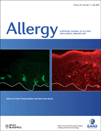X-chromosome Forkhead Box P3 polymorphisms associate with atopy in girls in three Dutch birth cohorts
Edited by: Hans-Uwe Simon
Abstract
To cite this article: Bottema RWB, Kerkhof M, Reijmerink NE, Koppelman GH, Thijs C, Stelma FF, Smit HA, Brunekreef B, van Schayck CP, Postma DS. X-chromosome Forkhead Box P3 polymorphisms associate with atopy in girls in three Dutch birth cohorts. Allergy 2010; 65: 865–874.
Background: The Forkhead Box P3 (FOXP3) gene, located on the X-chromosome, encodes a transcription factor that directs T cells toward a regulatory phenotype. Regulatory T cells may suppress development of atopy. We evaluated whether single-nucleotide polymorphisms (SNPs) of FOXP3 are associated with atopy development in childhood.
Methods: Seven SNPs in FOXP3 were genotyped in 3062 children (51% boys) participating in the Allergenic study, which consists of three Dutch birth cohorts (PIAMA, PREVASC and KOALA). Association of FOXP3 SNPs with total serum IgE and sensitisation (presence of specific serum IgE to egg, milk, and indoor, i.e. house-dust mite, cat, and/or dog allergens) was investigated at ages 1, 2, 4, and 8. Analysis of variance and logistic regression were performed, stratified for gender.
Results: Our most consistent finding was observed for sensitisation to egg and indoor allergens. In girls, five FOXP3 SNPs (rs5906761, rs2294021, rs2294019, rs6609857 and rs3761548) were significantly associated with sensitisation to egg at ages 1 and 2 and with sensitisation to indoor allergens at age 2 (P < 0.05), but not at 4 and 8, a finding that was observed across the three cohorts. Rs5906761 and rs2294021 were associated with remission of sensitisation to food allergens in boys, as tested in the PIAMA cohort.
Conclusion: This is the first study showing across three cohorts that X-chromosomal FOXP3 genotypes may contribute to development of sensitisation against egg and indoor allergens in girls in early childhood. In addition, an association with remission of sensitisation to food allergens existed in boys only.




